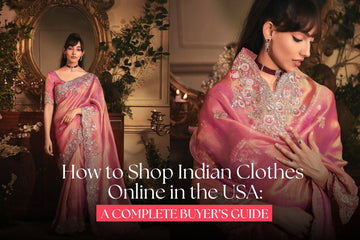Indian weddings are not just ceremonies; they are grand spectacles filled with tradition, color, and exuberance, where every detail, including attire, holds significant cultural importance. For men attending these celebrations, dressing appropriately is more than just a matter of personal style; it's a nod to tradition and a mark of respect for the occasion. However, navigating the labyrinth of Indian wedding fashion can be overwhelming, especially for those unfamiliar with the cultural nuances and traditional attire. Whether you're the groom, groomsmen, or a guest, striking the perfect balance between classic elegance and contemporary flair is essential. In this comprehensive guide, we'll delve into the must-have fashion elements that every man should consider incorporating into his ensemble for an Indian wedding. From understanding the symbolism behind traditional garments to exploring modern interpretations and accessorizing with finesse, this guide aims to equip you with the knowledge and inspiration to make a memorable sartorial statement on this auspicious occasion. So, whether you're embracing your heritage or simply looking to make a stylish impression, join us as we unravel the intricacies of men's fashion for Indian weddings.
Safa/Turban
In Indian culture, a "safa" or turban is a traditional headgear worn by men, particularly during weddings and other special occasions. The turban holds great significance in Indian weddings and is considered a symbol of honor, respect, and pride.
There are several reasons why men wear safas or turbans during India weddings:
Cultural Tradition: Turbans have been an integral part of Indian culture for centuries, particularly among the Sikh, Rajput, and Maratha communities. They symbolize a sense of tradition, heritage, and cultural identity.
Symbol of Respect and Dignity: Wearing a turban is often seen as a mark of respect and dignity, especially during important ceremonies like weddings. It signifies the groom's readiness to take on the responsibilities of marriage and family life.
Status and Prestige: In some communities, the style, color, and fabric of the turban may signify the wearer's social status, wealth, or lineage. For instance, in Sikh weddings, the groom typically wears a turban known as a "pagri," which holds deep religious and cultural significance.
Blessings and Protection: Turbans are believed to offer blessings and protection to the wearer. It's customary for family members or elders to place the turban on the groom's head during the wedding ceremony, symbolizing their blessings for a happy and prosperous married life.
Mojris/Juttis
Mojris or juttis are traditional Indian footwear known for their intricate designs, embroidery, and vibrant colors. They are typically made of leather or fabric and feature decorative elements such as beads, sequins, and thread work. Mojris and juttis are commonly worn during weddings and other festive occasions in India.
While the groom may wear mojris or juttis as part of his wedding attire, they are not exclusively reserved for him. In fact, both men and women attending the wedding, including family members, guests, and the bridal party, may wear mojris or juttis as part of their traditional outfits.
In weddings, the groom's mojris or juttis often match or complement his wedding attire, such as the color and design of his sherwani or other traditional ensemble. They add to the overall elegance and traditional charm of the groom's attire.
Similarly, female attendees at Indian weddings may also opt to wear mojris or juttis as part of their traditional attire, especially if they are wearing sarees, lehengas, or other ethnic outfits. Mojris and juttis are versatile footwear choices that can enhance the beauty of both men's and women's traditional attire during wedding celebrations.
Stole or Shawl
A stole or shawl is a piece of fabric typically worn around the shoulders or draped over the arms. It serves both functional and aesthetic purposes, providing warmth and adding a touch of elegance to an outfit. In Indian weddings, stoles or shawls are commonly worn by both men and women, albeit for different reasons and at different times during the wedding festivities.
For men, wearing a stole or shawl during an Indian wedding is more about style and adding a touch of sophistication to their attire. Here are a few occasions when men might choose to wear a stole or shawl during a wedding:
During Outdoor Ceremonies: If any part of the wedding ceremonies or celebrations takes place outdoors, especially during colder months or in regions with cooler climates, men may choose to wear a stole or shawl to keep warm while still looking stylish.
As an Accessory: Stoles or shawls can be worn as accessories to complement traditional Indian attire such as sherwanis, kurta-pajamas, or suits. They add texture, color, and a sense of elegance to the overall look.
During the Reception: Men attending the wedding reception, particularly if it's held in the evening or in air-conditioned venues, may opt to wear a stole or shawl as a fashion statement or to stay warm in cooler indoor settings.
As a Fashion Statement: Some men may choose to wear a stole or shawl purely as a fashion statement, regardless of the weather or the formality of the occasion. It can add a touch of flair and personality to their outfit.
Overall, while stoles or shawls are not mandatory for men to wear during Indian weddings, they can be worn as optional accessories to enhance their attire and add a touch of style and sophistication to the festivities.
Sherwanis
A sherwani is a traditional Indian garment worn by men, particularly on formal occasions such as weddings, festivals, and other special events. It is a long coat-like garment that typically features intricate embroidery, embellishments, and rich fabrics such as silk, brocade, or velvet. Sherwanis are often paired with churidar pants (tight-fitting trousers with gathers at the ankle) and a matching dupatta (scarf).
While the groom commonly wears a sherwani during his wedding ceremony, it's not exclusive to the groom. In fact, sherwanis are also worn by other male members of the wedding party, including the groomsmen, relatives, and guests, especially during traditional Indian weddings or formal celebrations.
Here are some occasions besides weddings where sherwanis can be worn:
Festivals: Sherwanis are commonly worn during festive occasions such as Diwali, Eid, and other cultural celebrations.
Formal Events: Sherwanis are appropriate attire for formal events like receptions, galas, or award ceremonies, particularly within Indian communities.
Cultural Events: During cultural events or performances that celebrate Indian heritage and traditions, men may choose to wear sherwanis as a nod to their cultural identity.
Parties and Celebrations: Sherwanis can also be worn to upscale parties, engagements, or other celebratory gatherings where formal attire is expected.
While sherwanis are often associated with weddings due to their elaborate designs and formal nature, they are versatile garments that can be worn on various occasions beyond weddings. Whether it's a festive celebration, a formal event, or a cultural gathering, the sherwani remains a timeless and elegant choice for men's traditional attire.


















